
South Yarra railway station is the junction for the Cranbourne, Frankston, Pakenham and Sandringham lines in Victoria, Australia. It serves the south-eastern Melbourne suburb of South Yarra, and opened on 22 December 1860 as Gardiners Creek Road. It was renamed South Yarra on 1 January 1867.
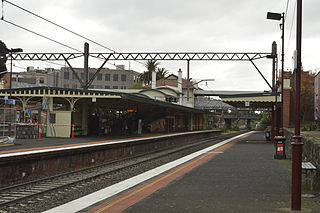
Malvern railway station is a commuter railway station that is part of the Melbourne railway network in Victoria, Australia. The station is located on the southern border of Malvern, a suburb of Melbourne, and was opened on 7 May 1879. The station complex consists of an island platform and two side platforms all accessed by a pedestrian bridge. There are two red brick Edwardian-era station buildings, constructed in 1914 as ticketing and staff offices. The entire complex is listed on the Victorian Heritage Register because of its architectural significance and its role in the development of Malvern as a significant metropolitan centre. The station is only partially accessible because of multiple steep access ramps.

Windsor railway station is located on the Sandringham line in Victoria, Australia. It serves the south-eastern Melbourne suburb of Windsor, and opened on 19 December 1859 as Chapel Street. It was renamed Windsor on 1 January 1867.

St Kilda station is a current tram stop and former railway station, located in the Melbourne suburb of St Kilda, Australia, and was the terminus of the St Kilda railway line in the Melbourne suburban rail system. It is one of the oldest surviving railway station buildings in Victoria. The building is currently used as retail premises, while the platform serves as stop 132 on tram route 96.

The Sandringham line is a commuter railway line in the city of Melbourne, Victoria, Australia. Operated by Metro Trains Melbourne, it is the city's fourth shortest metropolitan railway line at 17.9 kilometres (11.1 mi). The line runs from Flinders Street station in central Melbourne to Sandringham station in the south-east, serving 14 stations via South Yarra, Balaclava, Elsternwick, and Brighton. The line operates for approximately 20 hours a day with 24 hour service available on Friday and Saturday nights. During peak hour, headways of up to 5 to 10 minutes are operated with services every 10–20 minutes during off-peak hours. Trains on the Sandringham line run with a two three-car formations of Siemens Nexas train sets.
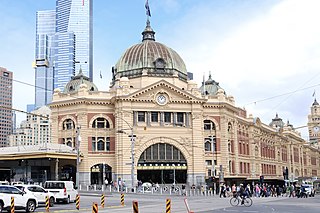
The Melbourne rail network is a passenger and freight train system in the city of Melbourne, Victoria, Australia. The metropolitan passenger rail network is centred on the Melbourne CBD and consists of 222 stations across 16 lines, which served a ridership of 99.5 million over the year 2021–2022. It is the core of the larger Victorian railway network, with links to both intrastate and interstate systems.
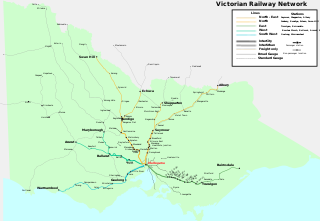
Rail transport in the Australian state of Victoria is provided by a number of railway operators who operate over the government-owned railway lines. The network consists of 2,357 km of Victorian broad gauge lines, and 1,912 km of standard gauge freight and interstate lines; the latter increasing with gauge conversion of the former. Historically, a few experimental 762 mm gauge lines were built, along with various private logging, mining and industrial railways. The rail network radiates from the state capital, Melbourne, with main interstate links to Sydney and to Adelaide, as well as major lines running to regional centres, upgraded as part of the Regional Fast Rail project.

The Sandridge Bridge is a historic bridge, originally carrying a railway, over the Yarra River in Melbourne, Victoria, Australia. It runs diagonally to the river's banks and is 178.4 metres (585 ft) long. In 2006 it was redeveloped as a pedestrian and cycle path featuring public art. It is the third bridge on the site and is listed on the Victorian Heritage Register.

Princes Bridge was a Melbourne railway station built in 1859 and was the terminus for all Epping line and Hurstbridge line trains. The station was named after the adjacent Princes Bridge, which crosses the Yarra River. Originally Princes Bridge station was isolated from Flinders Street station, even though it was adjacent to it, sited just on the opposite side of Swanston Street. Some years later the railway tracks were extended under the street to join the two stations, and Princes Bridge slowly became amalgamated into the larger Flinders Street station. This process was completed in May 1997.
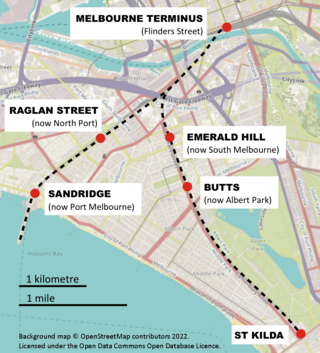
The Melbourne and Hobson's Bay Railway Company was a railway company in Victoria, Australia. The company was incorporated on 20 January 1853 to build the line from Melbourne to the port of Sandridge, now Port Melbourne.
The St Kilda railway line is a former railway line in Melbourne, Australia.

South Melbourne is a light rail station on the former St Kilda railway line, and was located in the Melbourne suburb of South Melbourne, Victoria, Australia. The station was adjacent to the intersection of Ferrars and Dorcas Streets, just minutes from South Melbourne Market. A pair of low-level side platforms, immediately north of the disused station, now serve route 96 trams on the light rail line, with a pedestrian crossing in between.
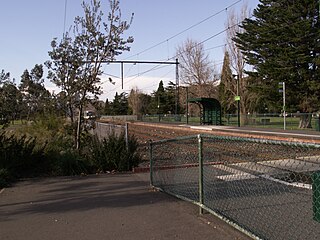
Graham Street is light rail station and former railway station on the former Port Melbourne railway line, in the inner Melbourne suburb of Port Melbourne, Victoria, Australia. Located to the north of Graham Street, between Evans Street and Station Street, the station has been demolished since 1987, and is now served by route 109 trams, stopping at a pair of low level platforms.

Montague Street is a light rail station and former railway station, on the former Port Melbourne railway line in the inner Melbourne suburb of South Melbourne, Australia. The station was located to the south of the Montague Street road underpass, between Woodgate Street and Gladstone Lane, with a large goods shed located on the Melbourne side of the station. The station buildings and platforms have been demolished, and there are now a pair of low-level platforms forming a tram stop on route 109.

Middle Park is a light rail station on the former St Kilda railway line, in the Melbourne suburb of Middle Park, on the corner of Canterbury Road and Armstrong Street. A pair of low-level side platforms now serve route 96 trams running on a light rail line. Other nearby light rail stops are at Fraser Street and Wright Street. Those and a number of other stops were added after the line was converted to light rail.

Albert Park is a light rail station on the former St Kilda line, located in the Melbourne suburb of Albert Park, Victoria. The station is located on Ferrars Street just to the north of Albert Road, just minutes walk from the Bob Jane Stadium, current home of the South Melbourne Soccer club and the former home of the South Melbourne Football Club. A pair of low level side platforms now serve route 96 trams on the light rail line.

The Newport Railway Workshops is a facility in the Melbourne suburb of Newport, Australia, that builds, maintains and refurbishes railway rollingstock. It is located between the Williamstown and Werribee railway lines.

Jolimont Yard was an array of railway lines and carriage sidings on the edge of the central business district of Melbourne, Australia. Located between Flinders Street station, Richmond Junction, the Yarra River and Flinders Street they were often criticised for cutting off the city from the river, being the site of many redevelopment proposals. The Princes Gate Towers were built over part of the yard in the 1960s, which themselves were replaced by Federation Square in the 2000s. The rail sidings themselves were progressively removed from the 1980s to the 1990s with only running lines today, but the area continues to be referred to as the 'Jolimont railyards' by Melburnians.

Melbourne and Hobson's Bay Railway Company 2-2-2WT (1854) was the first locomotive operated after the inauguration of a public railway line in Australia. It had 7+7⁄8 in (200 mm) diameter cylinders and was capable of producing 30.0 horsepower, reaching 25 mph (40 km/h) and hauling 130 tonnes.
North Port is a light rail station and a former railway station on Port Melbourne railway line, first significant railway in Melbourne, Australia. The station is located in the inner Melbourne suburb of Port Melbourne, Victoria, Australia. Though it was closed in 1987 for conversion to light rail, Melbourne tram route 109 now runs through the station with newly built low-floor platforms. The station was located to the south of Raglan Street and between Evans Street and Station Street.





















